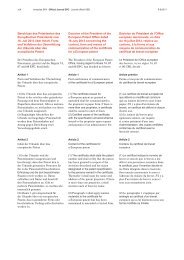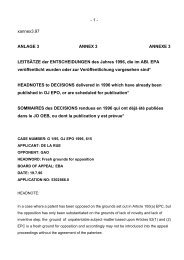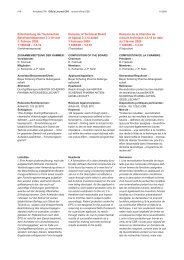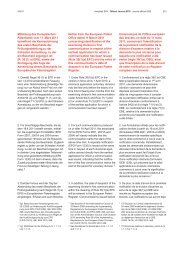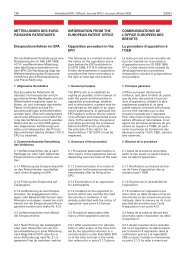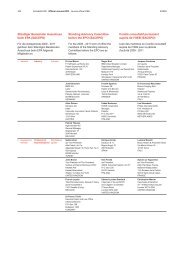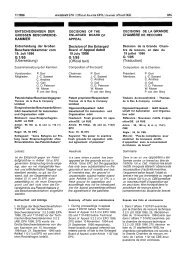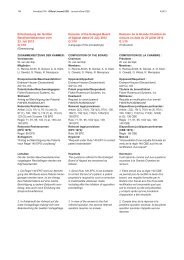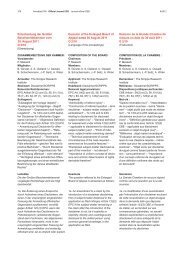Sonderausgabe 1 - European Patent Office
Sonderausgabe 1 - European Patent Office
Sonderausgabe 1 - European Patent Office
You also want an ePaper? Increase the reach of your titles
YUMPU automatically turns print PDFs into web optimized ePapers that Google loves.
118<br />
Regel 28<br />
Ausnahmen von der <strong>Patent</strong>ierbarkeit<br />
<strong>Sonderausgabe</strong> Nr. 1 ABl. EPA / Special edition No. 1 OJ EPO / Edition spéciale n° 1 JO OEB<br />
Nach Artikel 53 a) werden europäische<br />
<strong>Patent</strong>e insbesondere nicht erteilt für<br />
biotechnologische Erfindungen, die zum<br />
Gegenstand haben:<br />
a) Verfahren zum Klonen von menschlichen<br />
Lebewesen;<br />
b) Verfahren zur Veränderung der genetischen<br />
Identität der Keimbahn des<br />
menschlichen Lebewesens;<br />
c) die Verwendung von menschlichen<br />
Embryonen zu industriellen oder<br />
kommerziellen Zwecken;<br />
d) Verfahren zur Veränderung der genetischen<br />
Identität von Tieren, die geeignet<br />
sind, Leiden dieser Tiere ohne wesentlichen<br />
medizinischen Nutzen für den<br />
Menschen oder das Tier zu verursachen,<br />
sowie die mit Hilfe solcher Verfahren<br />
erzeugten Tiere.<br />
Regel 29<br />
Der menschliche Körper und seine<br />
Bestandteile<br />
(1) Der menschliche Körper in den<br />
einzelnen Phasen seiner Entstehung<br />
und Entwicklung sowie die bloße Entdeckung<br />
eines seiner Bestandteile,<br />
einschließlich der Sequenz oder Teilsequenz<br />
eines Gens, können keine<br />
patentierbaren Erfindungen darstellen.<br />
(2) Ein isolierter Bestandteil des<br />
menschlichen Körpers oder ein auf<br />
andere Weise durch ein technisches<br />
Verfahren gewonnener Bestandteil,<br />
einschließlich der Sequenz oder Teilsequenz<br />
eines Gens, kann eine patentierbare<br />
Erfindung sein, selbst wenn der<br />
Aufbau dieses Bestandteils mit dem<br />
Aufbau eines natürlichen Bestandteils<br />
identisch ist.<br />
(3) Die gewerbliche Anwendbarkeit einer<br />
Sequenz oder Teilsequenz eines Gens<br />
muss in der <strong>Patent</strong>anmeldung konkret<br />
beschrieben werden.<br />
Regel 30<br />
Erfordernisse europäischer <strong>Patent</strong>anmeldungen<br />
betreffend Nucleotid- und<br />
Aminosäuresequenzen<br />
(1) Sind in der europäischen <strong>Patent</strong>anmeldung<br />
Nucleotid- oder Aminosäuresequenzen<br />
offenbart, so hat die<br />
Beschreibung ein Sequenzprotokoll zu<br />
enthalten, das den vom Präsidenten des<br />
Europäischen <strong>Patent</strong>amts erlassenen<br />
Vorschriften für die standardisierte<br />
Darstellung von Nucleotid und Aminosäuresequenzen<br />
entspricht.<br />
Rule 28<br />
Exceptions to patentability<br />
Under Article 53(a), <strong>European</strong> patents<br />
shall not be granted in respect of<br />
biotechnological inventions which, in<br />
particular, concern the following:<br />
(a) processes for cloning human beings;<br />
(b) processes for modifying the germ line<br />
genetic identity of human beings;<br />
(c) uses of human embryos for industrial<br />
or commercial purposes;<br />
(d) processes for modifying the genetic<br />
identity of animals which are likely to<br />
cause them suffering without any<br />
substantial medical benefit to man or<br />
animal, and also animals resulting from<br />
such processes.<br />
Rule 29<br />
The human body and its elements<br />
(1) The human body, at the various<br />
stages of its formation and development,<br />
and the simple discovery of one of its<br />
elements, including the sequence or<br />
partial sequence of a gene, cannot<br />
constitute patentable inventions.<br />
(2) An element isolated from the human<br />
body or otherwise produced by means of<br />
a technical process, including the<br />
sequence or partial sequence of a gene,<br />
may constitute a patentable invention,<br />
even if the structure of that element is<br />
identical to that of a natural element.<br />
(3) The industrial application of a<br />
sequence or a partial sequence of a<br />
gene must be disclosed in the patent<br />
application.<br />
Rule 30<br />
Requirements of <strong>European</strong> patent applications<br />
relating to nucleotide and amino<br />
acid sequences<br />
(1) If nucleotide or amino acid<br />
sequences are disclosed in the<br />
<strong>European</strong> patent application, the<br />
description shall contain a sequence<br />
listing conforming to the rules laid down<br />
by the President of the <strong>European</strong> <strong>Patent</strong><br />
<strong>Office</strong> for the standardised representation<br />
of nucleotide and amino acid<br />
sequences.<br />
Règle 28<br />
Exceptions à la brevetabilité<br />
2007<br />
Conformément à l’article 53 a), les<br />
brevets européens ne sont pas délivrés<br />
notamment pour les inventions biotechnologiques<br />
qui ont pour objet :<br />
a) des procédés de clonage des êtres<br />
humains ;<br />
b) des procédés de modification de<br />
l’identité génétique germinale de l’être<br />
humain ;<br />
c) des utilisations d’embryons humains à<br />
des fins industrielles ou commerciales ;<br />
d) des procédés de modification de<br />
l’identité génétique des animaux de<br />
nature à provoquer chez eux des souffrances<br />
sans utilité médicale substantielle<br />
pour l’homme ou l’animal, ainsi que<br />
les animaux issus de tels procédés.<br />
Règle 29<br />
Le corps humain et ses éléments<br />
(1) Le corps humain, aux différents<br />
stades de sa constitution et de son développement,<br />
ainsi que la simple découverte<br />
d’un de ses éléments, y compris la<br />
séquence ou la séquence partielle d’un<br />
gène, ne peuvent constituer des inventions<br />
brevetables.<br />
(2) Un élément isolé du corps humain ou<br />
autrement produit par un procédé technique,<br />
y compris la séquence ou la<br />
séquence partielle d’un gène, peut<br />
constituer une invention brevetable,<br />
même si la structure de cet élément est<br />
identique à celle d’un élément naturel.<br />
(3) L’application industrielle d’une<br />
séquence ou d’une séquence partielle<br />
d’un gène doit être concrètement<br />
exposée dans la demande de brevet.<br />
Règle 30<br />
Prescriptions régissant les demandes<br />
de brevet européen portant sur des<br />
séquences de nucléotides et d’acides<br />
aminés<br />
(1) Si des séquences de nucléotides ou<br />
d’acides aminés sont exposées dans la<br />
demande de brevet européen, la<br />
description doit contenir un listage de<br />
séquences établi conformément aux<br />
règles arrêtées par le Président de<br />
l’<strong>Office</strong> européen des brevets pour la<br />
représentation normalisée de séquences<br />
de nucléotides et d’acides aminés.



